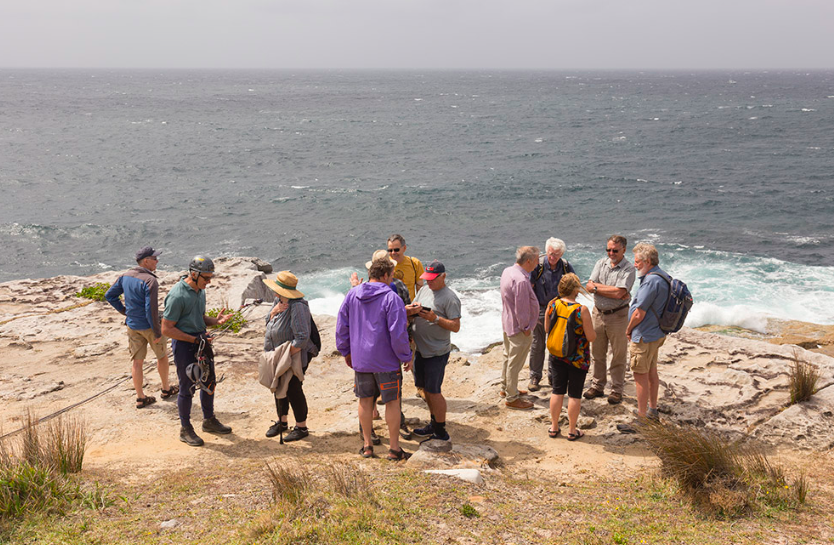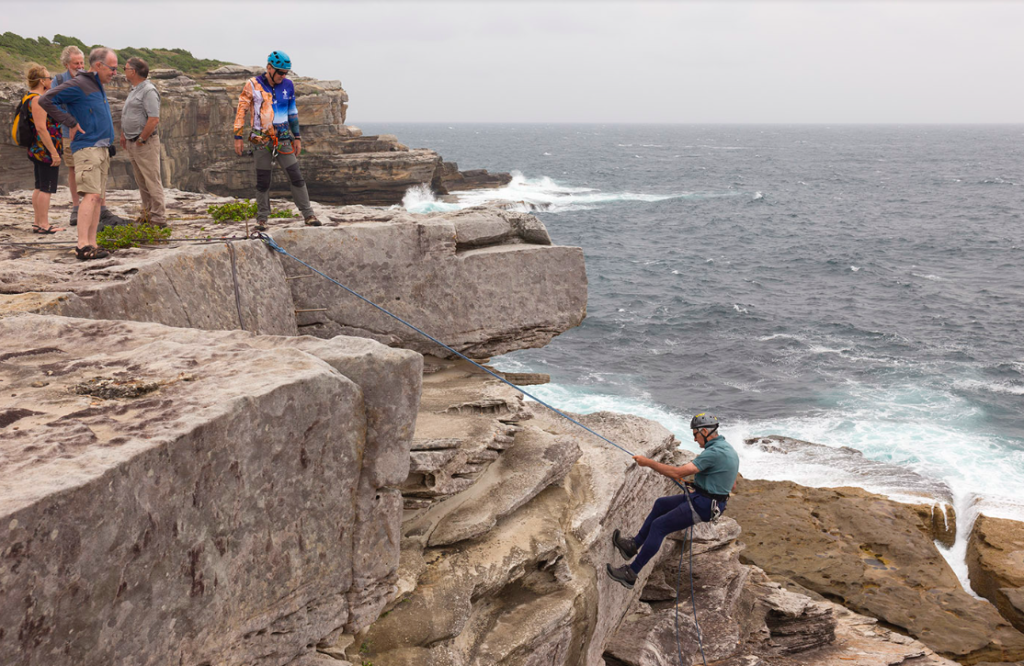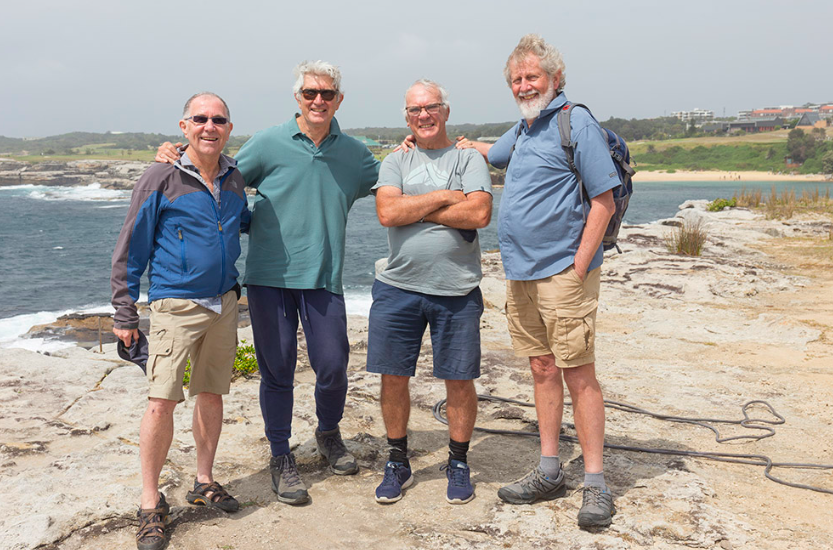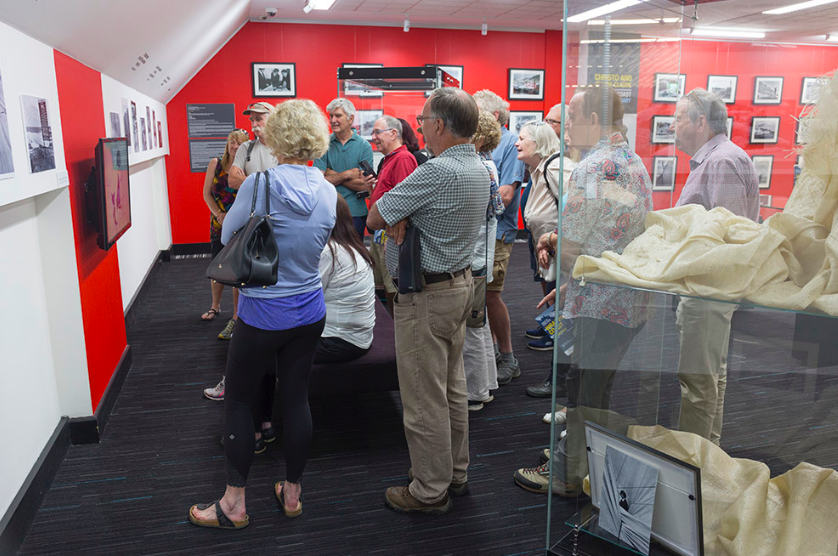by Michael Waite

Michael Waite is a Research Assistant at Kaldor Public Art Projects and also a tutor at the Australian Centre for Photography
On Saturday, November 30, approximately 20 rock climbers gathered at Little Bay for a reunion – 8 of whom had worked on Wrapped Coast in 1969. Michael Waite, Research Assistant at Kaldor Public Art Projects was there to listen to some stories from the climbers, who came all the way from New Zealand, Perth, Darwin, Brisbane and Canberra. Here we reproduce a few of their tales.
Megs Hill
Megs was, and still is a member of the Sydney Rockclimbing Club (SRC). The club was approached to supply people to abseil at Little Bay to help Christo and Jeanne-Claude create Wrapped Coast. Hearing that it was paid work “was like music to our ears”, said Megs.
She was on a Commonwealth scholarship, in the second year of her Social Work degree at UNSW. The most she had been paid up to then was $20 per week and that had to cover rent of $17 per week in one of the residential colleges, “So to get $20 a day was phenomenal!” she said. Her regular work was part time waitressing at University events, plus some babysitting. Megs worked most days for two weeks on Wrapped Coast. “It wasn’t just the money we were doing it for. It was a very new-age thing to have somebody come out and do something so stupendous as wrap up part of the coast, but it was really because I was with friends. We were a close-knit group of people, and doing what I loved, it was outdoors. It was exciting and it was physically demanding, and I’m very proud to say I was the first woman in NSW to get a Ramset licence.” She says that it was probably a twenty minute lesson, since there wasn’t much in the way of occupational health and safety training in those days.
The abseiling was difficult because the cliff was undercut, and you couldn’t see what the terrain was like beneath the material, billowing in the wind. It was hard to find your footing, and the material was slippery. The climbers were safety conscious, always checking their gear. After Wrapped Coast Megs went on a climbing trip to NZ with Warwick Williams, and her earnings went towards the fare. Megs appears in both of the Wrapped Coast documentaries.
Hugh Ward
Hugh was one of the main abseilers and was responsible for organising many of the others who could only commit for a few days. Hugh was there full-time as he was otherwise unemployed. While working on Wrapped Coast, Hugh sprained his neck when an anchor gave way and had to wear a neck brace for a couple of months, after which he was fully recovered. His wife Maureen was also a member of SRC but didn’t work at Wrapped Coast as she had a full-time job and was too honest to take sickies.
Ed
At the pub after our reunion abseil at Little Bay, Ed told us that he was the only person to be fired from Wrapped Coast. One day he was slacking off, sitting on the edge of the cliff smoking a cigarette and idly firing Ramset nails into the ocean. Christo came over and said “You’re finished”. Ed told Hugh Ward who then went to Christo and said “One out, all out!”. So Christo allowed Ed to stay on.
Lee Smith
Lee can’t recall how many days he worked on Wrapped Coast, but not many. In 1969 he was a graduate surveyor, had studied at UNSW, was working for the Commonwealth Government, going through his Licensing Board exams and working in an office in the Sydney CBD. He would take sickies from his day job to work on Wrapped Coast. Lee says, “At one stage I was abseiling down the cliff and I looked across the headland and there was the local news camera zooming in on me. I’m thinking, ‘Oh no, my boss is going to be seeing me on the news tonight!’ … But they never found me out”.
Bruce Postill
He was the President of SRC in 1969, and also the rock rescue officer, so had a lot to do with the Police Rescue Squad. He thinks that the initial approach was made to Police Rescue for abseilers and they put Kaldor in touch with Sydney Rock Climbers.
“I don’t know how the payment came about, why we were paid, we were all pretty interested in the whole project. I found, especially at the end, when it was completed, I was a bit overawed by it really because when you’re actually working on it you don’t get to see the scale of it.”
Bruce can’t recall how many days he worked there. His day job was as a letterpress printer. He would work for six to eight months per year and then spend the rest of the time in New Zealand mountaineering.
“I think it was a pretty amazing project and I’m really pleased to have been involved with it. I’ve still got my Christo badge.”
He can’t recall if he took sickies or was unemployed at the time. Bruce was initially asked to be the supervisor of climbers but wasn’t able to commit so he asked Hugh Ward to do it.
His thoughts on working on Wrapped Coast vs working as a printer. “This was exciting and interesting, abseiling, and I think creative too, the whole concept of changing the landscape.”
Warwick Williams
Warwick was in his final year of university. It was a great opportunity to earn some extra money.
Looking at his Ramset card. Accredited Operator. 10th October 1969 is the date of the signature.
The climbers were paid $20 per day. It helped him to buy a camera and pay for a mountaineering trip to New Zealand. It was hard work but enjoyable “On the whole it was jolly good fun”
“It was a great adventure. Domestic adventure. Things can be had in your backyard.”
Keith Bell
By the time Keith started a lot of the wrapping had already been done. Keith was in his early 20s and was a structural engineer and drafter at the Water Board.
He recalls getting paid $20 per day. That was good money in 1969. He was an engineer/draftsman for the Water Board and thinks he was only earning about $20 per week there. It cost $1.50 to fill the tank of his Mini Minor with petrol.
“Twenty dollars a day was fantastic.”
He doesn’t remember how many days in total he worked on Wrapped Coast. He was having to take sickies from the Water Board.
“Wrapped Coast was a real team work thing, there was a lot of friendship and bonhomie. I can’t remember a terse word. I remember working with my mates, and working with other people and everyone striving towards a goal in a really amicable, friendly sort of way. It’s really nice when there’s a melding of people doing various things towards a project. It had various aspects from the flat to the steep to the seashore, and it needed teamwork, and the teamwork was there. That’s the thing that I really remember, that there was teamwork, the other people doing the sewing, us working on the face.”





